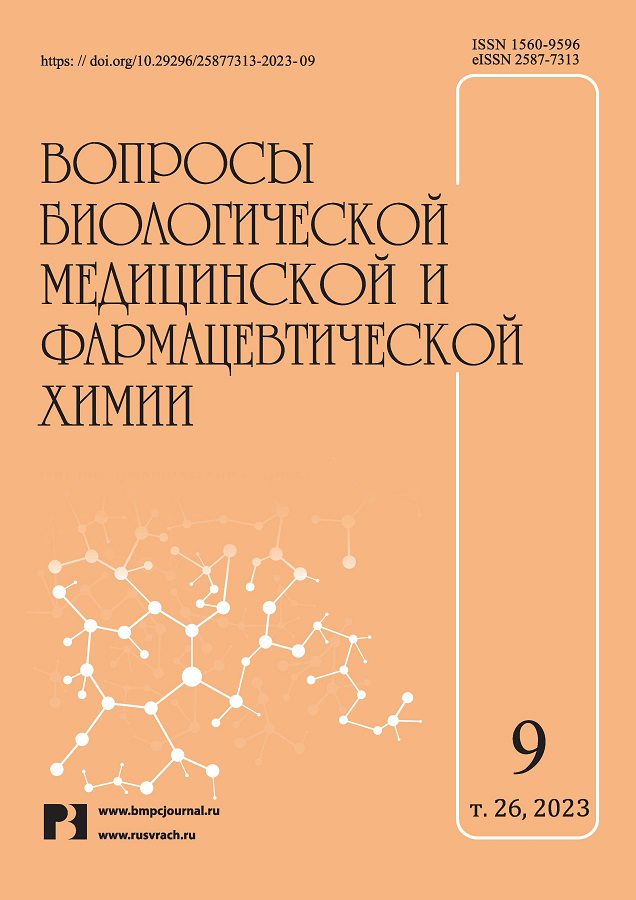Combined method for quality control of colloidal silver
- 作者: Kolyabina E.S.1, Maksimova T.V.1
-
隶属关系:
- Peoples' Friendship University of Russia
- 期: 卷 26, 编号 9 (2023)
- 页面: 48-51
- 栏目: Pharmaceutical chemistry
- URL: https://journals.eco-vector.com/1560-9596/article/view/601802
- DOI: https://doi.org/10.29296/25877313-2023-09-07
- ID: 601802
如何引用文章
详细
Relevance. Silver nanoparticles are interesting as an alternative to antibiotics and as their carrier. Bioavailability of silver is affected by particle size, morphology, and concentration. The studied combination of methods is promising for the rapid detection of technological defects in production and the fight against counterfeiting.
Objective. To develop a combined method for quality control of silver-containing colloidal solutions. This method in addition to elemental determination will consider the disperse characteristics of particles.
Material and methods. Four silver-containing preparations were studied: ProtargolLor (P.J.S.C. “Pharmstandard”, Kursk); Argitos colloidal silver (“Nanosphere”, Russia), Argent Colloidal (Nutri expert, France); Granions d’Argent (Laboratoire des Granions Le Mercator, France). The study was carried out using Energy dispersive spectrometer Shimadzu EDX-7000 (Japan), Laser hydrodynamic particle size analyzer Zetasizer (Malvern Instruments, UK).
Results. In this article we propose the use of a combined method for the quality control of silver-containing preparations. The express X-ray fluorescence method is supplemented by the method of dynamic laser light scattering. This combined method allows to determine the composition and size spectra of the particles of the studied samples. It will significantly reduce costs and protect the laborants from the toxic effects of reagents used for mineralization.
Conclusion. The combination of disperse and elemental analysis methods is promising for quality control of silver-containing pharmaceuticals. This technology will detect counterfeit and manufacturing defects.
全文:
作者简介
E. Kolyabina
Peoples' Friendship University of Russia
编辑信件的主要联系方式.
Email: kolyabina.ks@gmail.com
Post-graduate Student, Department of Pharmaceutical and Toxicological Chemistry, Medical Institute
俄罗斯联邦, MoscowT. Maksimova
Peoples' Friendship University of Russia
Email: kolyabina.ks@gmail.com
Ph.D. (Pharm.), Associate Professor, Department of Pharmaceutical and Toxicological Chemistry, Medical Institute
俄罗斯联邦, Moscow参考
- Talarska P., Boruczkowski M., Z ̇urawski Ja. Current Knowledge of Silver and Gold Nanoparticles in Laboratory Research – Application, Toxicity, Cellular Uptake. Nanomaterials. 2021; 11: 2454.
- Vishwanath N., Whitaker C., Allu S., Clippert D., Jouffroy E., Hong J., Stone B., Connolly W., Barrett C.C., Antoci V., Born Ch.T., Garcia D.R. Silver as an Antibiotic-Independent Antimicrobial: Review of Current Formulations and Clinical Relevance. Surgical Infections. 2022; 769: 780.
- Sredojević D., Stavrić S., Lazić V., Ahrenkiel S.Ph., Nedeljković J.M. Interfacial charge transfer complex formation between silver nanoparticles and aromatic amino acids. Phys Chem Chem Phys. 2022; 24(27): 16493–16500.
- Slater K., Sommariva E., Kartono F. A Case Study of Argyria of the Nails Secondary to Colloidal Silver Ingestion. Cureus. 2022; 14: 10.
- Kumar A., Goia D.V. Comparative Analysis of Commercial Colloidal Silver Products. Int. J. Nanomedicine. 2020; 15: 10425–10434.
- Hadrup N., Lam H.R. Oral toxicity of silver ions, silver nano-particles and colloidal silver -a review. Regul. Toxicol. Pharmacol. 2014; 68(1): 1–7.
- Makarova M.P., Syroeshkin A.V., Maksimova T., Matveeva I.S., Pleteneva T. Features of Microelements Express-determination in Medicinal and Nonoficinal Plants by X-Ray-Fluorescence Analysis. Drug Development & Registration. 2019; 8(2): 93–97.
- Syroeshkin A.V., Makarova M., Maksimova T., Pleteneva T.V., Zlatskiy I. Development of zinc-enriched medicinal and food plants. Systematic Reviews in Pharmacy. 2020; 11(10): 726–731.
- Государственная фармакопея Российской Федерации XIV издания, ФС Серебра протеинат взамен ФС 42-1573-88 / 2018 (Gosudarstvennaja farmakopeja Rossijskoj Federacii XIV izdanija, FS Serebra proteinat vzamen FS 42-1573-88 / 2018).
- Matveeva I.S., Syroeshkin A.V., Chikviladze G.N. 10 years of intercomparison exercises in IAEA system. Trace elements in medicine. 2010; 11(2): 11–14.
- International atomic energy agency. Worldwide Interlaboratory Comparison on the Determination of Trace Elements in Biota Sample IAEA-470. IAEA Analytical Quality in Nuclear Applications Series. 2018; 56: 4–15.
- International atomic energy agency. Worldwide Interlaboratory Comparison on the Determination of Trace Elements and Methyl Mercury in Sediment Sample. IAEA Analytical Quality in Nuclear Applications Series. 2019; 60: 3–16.






